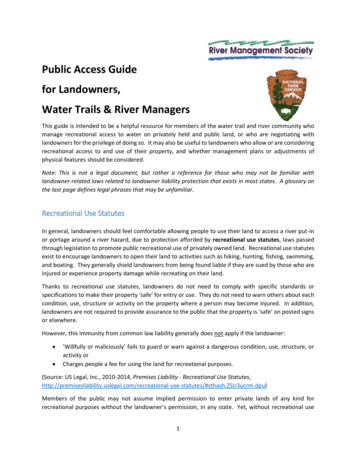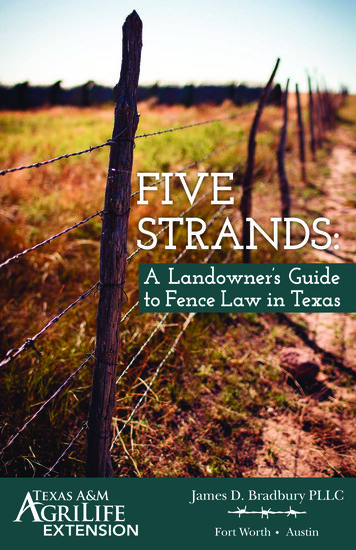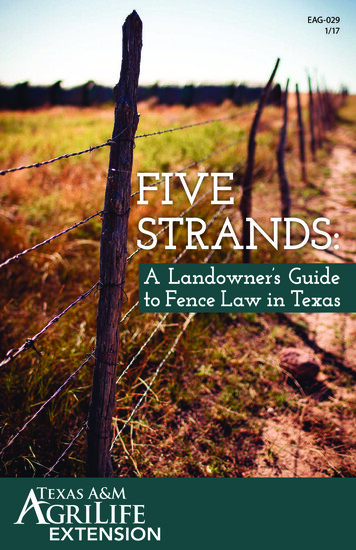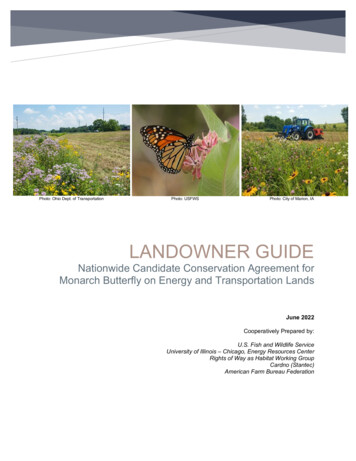
Transcription
Public Access Guidefor Landowners,Water Trails & River ManagersThis guide is intended to be a helpful resource for members of the water trail and river community whomanage recreational access to water on privately held and public land, or who are negotiating withlandowners for the privilege of doing so. It may also be useful to landowners who allow or are consideringrecreational access to and use of their property, and whether management plans or adjustments ofphysical features should be considered.Note: This is not a legal document, but rather a reference for those who may not be familiar withlandowner-related laws related to landowner liability protection that exists in most states. A glossary onthe last page defines legal phrases that may be unfamiliar.Recreational Use StatutesIn general, landowners should feel comfortable allowing people to use their land to access a river put-inor portage around a river hazard, due to protection afforded by recreational use statutes, laws passedthrough legislation to promote public recreational use of privately owned land. Recreational use statutesexist to encourage landowners to open their land to activities such as hiking, hunting, fishing, swimming,and boating. They generally shield landowners from being found liable if they are sued by those who areinjured or experience property damage while recreating on their land.Thanks to recreational use statutes, landowners do not need to comply with specific standards orspecifications to make their property ‘safe’ for entry or use. They do not need to warn others about eachcondition, use, structure or activity on the property where a person may become injured. In addition,landowners are not required to provide assurance to the public that the property is ‘safe’ on posted signsor elsewhere.However, this immunity from common law liability generally does not apply if the landowner: ’Willfully or maliciously’ fails to guard or warn against a dangerous condition, use, structure, oractivity orCharges people a fee for using the land for recreational purposes.(Source: US Legal, Inc., 2010-2014, Premises Liability - Recreational Use eational-use-statutes/#sthash.ZSU3ucrm.dpu)Members of the public may not assume implied permission to enter private lands of any kind forrecreational purposes without the landowner’s permission, in any state. Yet, without recreational use1
statutes visitors could consider themselves to be invitees or licensees (if they had paid for the privilege)with a clear right to sue the landowner in the event of injury.Visit Liability and Recreational Use Statutes (American Whitewater, December 3) to find state-specific recreational use statutes.Private LandownersCharging FeesLandowners are generally immune from liability if they do not charge a fee to use their property forrecreational purposes. Requiring payment to use one’s property in order to access a river or other bodyof water can play a big part in determining liability and protection from legal action on private land andlandowners may not be protected if fees are charged. State recreational use statutes address such fees.Importantly, there are several instances in which landowners are still protected when a fee is charged: In Alabama, if the land use is non-commercial;In Massachusetts, if it is a donation;In Nebraska, if the fee is only charged for groups;In North Carolina, if the fee applies to recreational uses other than trails;In South Dakota, if it is a non-monetary gift up to 100;In Texas, if revenue from fees do not exceed two (2) times the property taxes;In Virginia: if the fees go towards maintaining the land;In Wisconsin, if the total revenue does not exceed 2,000 annually; andIn many states, if a fee is charged but the land is leased to a public agency.Some landowners may decide to collect a fee to construct or maintain land access or a launch that hassuffered wear by public use. They may decide to accept donations through a donation box on theproperty, with a message to the public such as, “Donations accepted for use of the facilities,” and “Use atyour own risk.” If you are a landowner and you are considering instituting a fee to use your land forrecreation, check with state and local officials to verify whether or not the type and amount that is beingcharged will affect your exposure to risk.Protection and liability are connected matters. To illustrate this point: charging a fee does not free thelandowner of all liability, and charging a minor fee that covers-routine maintenance of the property maynot increase a landowner’s liability.Example: Tubing Accident in ArizonaThis article explains how charging fees relates to liability and protection considerations within the contextof state recreational use statutes. In this example, a participant (Stramka) of a commercialtubing/shuttling operation on a river in Arizona sued the recreation provider (Salt River Recreation) fornegligence. The article points out factors that are taken into consideration with such claims betweenindividuals and outfitters on publicly accessed waterways and describes the role of an ‘occupant’ ofpremises versus a ‘user’ of premises, a key component of determining liability.2
(Source: Court of Appeals of Arizona, July 21, 1994, “Recreation Immunity Denied to River FloatConcession: Stramka v. Salt River Recreation, Inc.” from Recreation and Parks Law Reporter (RPLR) casereport, -case.htm)Here are some general landowner rules of thumb: You are generally immune from liability if there is nothing on your property that could beconsidered to be malicious;Charging fees strongly increases your chances of being liable; andNot charging fees strongly increases your protection.Consult your state recreational use statutes, local organizations (paddling clubs, etc.) and personal legalcounsel for updated and additional guidance before making decisions or changing policy concerning publicrecreational use access on your property. In addition, review your insurance coverage thoroughly andcontact an agent to be clear about your coverage and potential exposure.Dangerous ConditionsIt is very important for land management organizations to partner with landowners when evaluatingwhether or not there are examples of dangerous conditions on their property and if so, determining howto remove or reduce the risk of injury at those locations.Ask yourself, “Is there anything on my property that could be thought of as dangerous?” If the answer is‘yes’, someone who is injured there might accuse you of malicious conduct: you should considermodifying or removing the feature or aspect of the feature that may cause harm.Generally, you are not protected if you willfully, maliciously, or deliberately cause an injury, or know aboutconditions on your property that could be seen as malicious. Examples of such conditions are: glass andnails purposely dispersed in a parking area; barbed wire placed out of sight at ’tripping level’ along paths;and concrete and/or rebar in the water at a river access site.You could be held responsible for the injury taking place if evidence exists that you: Knew that a dangerous condition existed;Were aware that an injury could result from that condition; andTook no action in the face of such knowledge.These refer to a ‘known’ condition. If you are not aware of a dangerous condition, you are not requiredby law to investigate your land for every possible place that might be dangerous. In other words, byallowing public access to your property for recreational purposes, you are not responsible or liable fordangerous conditions about which you are unaware.Example: Fatality in Texas City ParkThis article illustrates how, thanks to a recreational use statute, a landowner generally owed no duty towarn or protect people from the dangers of natural conditions. It discusses how a college student in Waco,Texas died when a natural cliff he was sitting on collapsed underneath him, causing him to fall3
approximately 60 feet. The city of Waco was sued by the student’s estate, saying that his death wascaused by its gross negligence, thus waiving its recreational use statute-based immunity. The courtsdetermined that in this situation, the City did not owe the student a duty to warn or protect against thedangers of natural conditions. The court emphasized that it seemed that while the rock wall and signplaced by the City in front of the cliff were man-made conditions, the cliff itself was natural and unaltered.(Source: Supreme Court of Texas, November 20, 2009, “City of Waco v. Kirwan” from FindLaw copyright2015, 9.html)Attractive NuisancesLandowners commonly allow recreational access to their property by simply not posting ‘No-Trespassing’or similar signs: the public has explicit or implied access for recreational purposes. In some states, sucha landowner may be held liable for injuries sustained by a child under the age of 18 due to what might beconsidered an attractive nuisance. An attractive nuisance is a hazardous object or condition on the landthat is likely to attract children who are unable to appreciate the risk posed by the object or condition.Attractive nuisances include railroads, swimming pools, construction sites, power lines and towers,manmade ponds and fountains, discarded appliances, abandoned automobiles, farm equipment, andwells or holes in the ground.Generally, landowners have no responsibility to make natural bodies of water (natural lakes, streams, andrivers) ’safe’ when they are not designated for swimming. They are considered an open and obvious riskto the public, including children who are old enough to be on their own.Landowners are likely to be liable if Trespass by children is foreseeable;The landowner knows or has reason to know about the danger;Children will not be able to protect themselves from the danger;The burden of eliminating the danger is slight compared to the gravity of the potential harm; andReasonable care has not been taken to eliminate the danger or otherwise protect children.This link provides more information on how to survey your property for water-related attractivenuisances: Water-Themed Attractive Nuisances Checklist, National Children’s Center for Rural andAgricultural Health and Safety, esChecklist.pdfIf you are a landowner and believe you may have a feature similar to the examples listed above on yourproperty, you should make a serious effort to remove the hazardous situation or adequately protect itfrom remaining as a danger before allowing recreational access to the public.4
Frequently Asked QuestionsHere are a few questions that address liability considerations relating to public access on private landsand commonly create concern for private landowners.Q: I have a land trail across my land and I want to open it to boaters, but I don't want to get sued ifsomebody gets hurt. What can I do?A: Locate and review your state's recreational use statute. You can find this through your local law libraryor website for your state attorney general, or American Whitewater (866-BOAT-4-AW). Chances are goodthat your state has one that limits your liability considerably. It is most likely that you cannot charge forthe use of your land and still be protected, and that you are protected against malicious conduct (see‘Dangerous Conditions’ above)’. Learn what is required to ‘open’ your land to the public in your state. Moststates consider the lack of ’No Trespassing‘ signage to communicate implied permission and sufficient toget protection of the statute: others such as Rhode Island and Delaware require landowners to takeaffirmative measures to demonstrate their intent to open their land to the public.Q: I plan to open a private parking area for river access on my property. If I charge people to use it, howdoes that affect my liability?A: In most states, a landowner who charges for the use of his or her land cannot claim protection fromliability under a recreational use statute. This is mainly because the intent of the statute is to open privateland to public recreational use, not to insulate commercial enterprises from liability. By charging people touse their land, landowners are in effect acting commercially and therefore owe a higher standard of careto those using the land. (Liability for commercial enterprises is not addressed here.) Some states allow alandowner to charge a small fee for maintenance of the land, setting a maximum dollar amount that thelandowner can charge and still be protected by the statute. Check your state's statute to see how itaddresses ‘payment for use.’Q: What kind of conduct am I liable for if I allow people to access the river from my land?A: Landowners are liable for dangerous conditions on their land only if they know of the condition andpurposely choose not to warn others or safeguard others from that condition. Landowners are thereforenot responsible for unknown conditions of their land and are not required to ensure the safety of their landshould they open it up for public recreational use. Check your state's statute to see how it addressesmalicious conduct (see ‘Dangerous Conditions’ above)’.Q: If I allow people to access the river from my land, do they need to sign a waiver in order for me to beprotected from liability?A: Generally, no. To be extra safe, a landowner can post "Enter at your own risk" signs to put users onnotice that there may be dangerous conditions on the land. Also, it cannot be stressed enough that theselaws put the responsibility of care on the users, not on the landowners. Review your state's statute to findout the status of landowner liability and the level of protection it provides.5
Q: What is ’adverse possession,’ and does it affect my liability if I grant public access to my property?A: Adverse possession is a way for someone other than the landowner to obtain ownership by continualuse or possession of land without permission or objection by the actual landowner. Adverse possession isnot directly tied to liability, but it can become an issue when injury or loss occurs on private property usedby the public for recreation.Q: If I open my land to public access for recreation, could I become subject to adverse possession?A: Generally, no. Landowners can open their land to recreational use with the knowledge that they canclose it when they wish without worrying about the possibility of the public gaining a permanent right tothe land. To help ensure against someone gaining property ownership via adverse possession, you can post‘No Trespassing‘ signs and restrict access at entry points with gates.Q: Suppose emergency medical services travel across my property for a rescue. Who is responsible forrestoration costs?A: This is not so much a question of the landowner’s exposure to the public, but a question of whether aprivate citizen can seek compensation or other recourse for damage of private property by the public or agovernment agency. Contact the jurisdiction responsible for providing the emergency services.Q: Is it true that as a landowner I can be sued by a visitor who has suffered an injury, and that the courtshould dismiss it? Will I still have to deal with lawyers’ fees and time and energy spent dealing with thecourt system?A: Recreational use statutes provide considerable protection to landowners, but someone can still chooseto sue you. Though few lawsuits against a landowner by someone recreating on their land have succeeded,defending oneself can become expensive. Remember to review your homeowners’ insurance policy andcontact your personal legal counsel to learn about potential coverage of legal fees in case of a lawsuit: inmany states, the person suing the landowner has to pay all legal fees if the suit is unsuccessful.Note: A great deal of the information in this reference is used can be found on the American Whitewater websitepage entitled ‘Liability and Recreational Use Statutes.’6
Public LandownersLiability for accidents occurring on lands owned by federal, state, and local jurisdictions such as countiesand towns differs from those owned by private parties. Public agencies possess sovereign immunity, alegal privilege that protects governments from being sued for injuries related to recreational use.Federal Government LandownersThe federal government has a duty to use reasonable care to keep the premises safe, and to guard orwarn the visitor from any hidden danger or defect that presents a reasonably foreseeable risk of harm.The federal government has been sued only rarely for damages related to injury caused by an event thattakes place on public land or waterway. The Federal Tort Claims Act, a federal statute, does permit privateparties to sue the United States in a federal court for negative actions that result in civil legal State and Local Government LandownersMost local jurisdictions are protected from legal action related to injury on public land (including parks,sidewalks, etc.) or water. State sovereign immunity waiver statutes provide that there is generally noliability for the state unless, and only to the extent that, the state waives its immunity.A higher level of protection may be effected by an additional agreement, such as a recreation easement,when recreation is added as one of the functioning purposes of an otherwise dangerous obstacle. Here isan example:After a large flood in the town of Lyons, Colorado on Saint Vrain Creek, the towncoordinated with the state to build a kayaking ‘play wave’ as part of the reconstructionefforts. Most of the surrounding land was owned by the town of Lyons for park purposes,but a ditch company owned an easement for its diversion structure and fee-simpleownership for the land under the ditch and inlet structure. This recreational use easementlimited the ditch company’s liability and increased protection in the case of an injury.*Contact the manager of your local land or field office, and if necessary, your state attorney general withspecific questions about liability to recreation on public property.Volunteering on Federal Land - Individuals of members of groups who participate in volunteer activitieson federal, state or local lands may be covered by the entity they serve if injured while volunteering. Ifyou have questions about this topic, ask your area manager about the nature of their liability andvolunteer protection program.* If the surrounding land was privately owned, the owners could limit their liability under the recreationaluse statute through a recreational use easement (according to Colorado law).7
Key Terms GlossaryAdverse Possession: Ownership gained by continual use or possession of land by someone other than thelandowner, without permission or objection by the actual landowner.Attractive Nuisance: A hazardous object or condition on private land that is likely to attract children whoare unable to appreciate the risk posed by the object or condition. Landowners may be held liable forinjuries to children trespassing on the land if the injury is caused by the object or condition.Duty of Reasonable Care: In general, land managers have a ‘duty to use reasonable care’ to keep thepremises safe and to guard or warn visitors from a hidden danger or defect that presents a reasonablyforeseeable risk of harm.Federal Tort Claims Act: A law that enables a person to sue the United States in federal court for “moneydamages for injury or loss of property, or personal injury or death caused by the negligent or wrongfulact or omission of any employee of the Government while acting within the scope of his office oremployment, under circumstances where the United States, if a private person, would be liable to theclaimant in accordance with the law of the place where the act or omission occurred.” (28 U.S.C.A. §1346(b))Invitee: Recreational user who enters land for the benefit of the landowner and is required to pay a feeor provide a service in exchange for the right of access. The responsibility of the landowner to therecreational user increases, since a fee or service is required and the user generally assumes that theproperty and other conditions are safe. Water Trails & River ManagersLandowner: The legal owner of the land, a tenant, lessee, occupant, or person in control of the premises.Some statutes also consider the holder of an easement an ‘owner.’ It is important to understand that ifsomeone is renting your property, or you are a tenant on someone else’s property, the renter could beliable if an injury occurs.Liability: The quality or state of being obligated or legally responsible for one’s acts or omissions.Licensee: Someone who enters property with the permission of the landowner and is not required to paya fee or render a service for the right of access. In other words, licensees enter property to further theirown purposes, not the landowners’. Landowners have a greater degree of responsibility to licensees thantrespassers in that they have a duty to warn of known dangers.Malicious Conduct: If the landowner willfully, maliciously, or deliberately causes an injury. Many courtsrequire actual knowledge of a dangerous condition, knowledge that an injury could result from thatcondition, and inaction in the face of such knowledge.Negligence: Four elements of negligence must be met for liability to be established: 1) existence of dutyof reasonable care; 2) breach of duty; 3) the breach of duty was the proximate (legal) cause of harm; and4) the victim sustained harm (injury or property damage).Payment for Use: Most recreational use statutes do not protect landowners from liability if the landowneropened up his or her land in exchange for payment. Whether or not a payment for use was made seemsa relatively simple question: however, the issue arises in litigation and the results vary from state to state.8
Recreational Purpose/Recreational Use: Definitions usually include a list of activities such as hiking,swimming, fishing, pleasure driving, nature study, etc. The phrase “includes, but is not limited to” mayappear to prevent an overly narrow interpretation of the phrase ‘recreational use.’Recreational Use Statute: A term given to legislation generally intended to promote public recreationaluse of privately owned land. The statute does this by granting landowners broad immunity from liabilityfor personal injuries or property damage suffered by land users pursuing recreational activities on theowner's land.Sovereign Immunity: A principle with origins in early English common law where the king was immunefrom suit by his subjects. The rationale was that, since law emanated from the sovereign, he could not beheld accountable in courts of his own creation.Tort: The legal term for a civil wrong, other than breach of contract that results from when one person’saction causes injury to another and for which a remedy may be obtained, usually in the form of damages.Trespasser: Someone who enters land uninvited and without the consent of the landowner. Usually,landowners are only liable for trespasser injuries that result from willful/malicious misconduct. A keyelement excusing landowner liability is the lack of knowledge of the trespassers presence.AcknowledgementsThe River Management Society thanks the National Park Service for their support and guidancethroughout the process of preparing this resource, and American Whitewater for their excellent onlineexplanation of and links to state recreational use statutes. We thank the individuals below for the timeand energy they offered when reviewing, editing, and offering guidance with enthusiasm and patience.Kevin Colburn - American WhitewaterAttila Bality, Charlotte Gillis, Julie Isbill, Burnham Martin, Lelia Mellen, Peggy Pings, Bob Ratcliffe, LindaStonier, Cassie Thomas, Angie Tornes, and Corita Waters - National Park ServiceJohn Putnam - Kaplan Kirsch & Rockwell LLPDave Schade - Alaska Department of Natural Resources9
or website for your state attorney general, or American Whitewater (866-BOAT-4-AW). Chances are good that your state has one that limits your liability considerably. It is most likely that you cannot charge for the use of your land and still be protected, and that you are protected against malicious conduct (see Dangerous onditions above) [.











